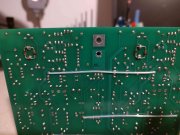I am interested in the white oak board. I cant seem to find a schematic or a forum thread discussing the circuit. I’ve seen the photos and they are very impressive.
The White Oak Audio PL14_20 Rev G1 Dual Mono Control Board can be found here:
https://www.whiteoakaudio.com/estore.aspx
You will receive the proprietary schematic after your purchase. Here is some history of the WOA Control Board.
Phase Linear had become known as "Blaze Linear" or "Flame Linear" in the 1980s and 1990s because their control boards had a tendency to 'Latch up' at Turn On and this condition sent the full rail voltage (80VDC for PL400, 100VDC for PL700) directly to the Speaker Outputs, typically the Left Speaker.
This was caused by transistors in the front end of the circuit turning on fully and passing the rail voltage through the circuit. Phase Linear was aware of the problem but could not solve it. Not all amplifiers were affected but many very expensive speakers were trashed over time.
Joe King at White Oak Audio is a talented Electrical Engineer and decided to re-create the Phase Linear PL14/PL20 control board to eliminate the Latch Up problem in 2010. His first release was Rev A and although it did improve the original circuit design by, 1) using modern technology to double side the board, redesign the layout, and increase the thickness and width of many traces, 2) utilize voltage regulation for onboard DC Power instead of large power resistors, 3) use modern high grade components, and 4) improved the grounding paths on the control board; this did not prevent the new Control Board from Latching Up.
Joe took his design to an eSPICE simulator program and discovered the source of the problem. Capacitor C6 was charging to rapidly and allowing Q2 to turn on fully. To solve this problem, two signal diodes were placed back to back across C6 and this slowed the charging enough to let the circuit stabilize at Turn On (see the picture below of my modified Rev A Control Board).

Later revisions incorporated those signal diodes and eventually the front end transistors were replaced by OPAMP circuits similar to the later Phase Linear PL36 control boards. We have never seen a Latch Up since and often wonder if Phase Linear would still be in business today if they had been able to solve this problem.
Of course the current Rev G1 Control Board is the ultimate Phase Linear replacement thanks to the Dual Mono configuration and four precision +/-15VDC power supplies onboard.

